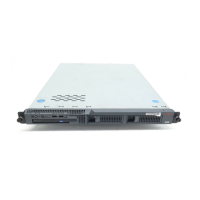Replacing the SAMP on the Avaya S8500B server
03-300529 Issue 4 January 2008 125
Figure 35: S8500B and SAMP connections and network interfaces
S8500B SAMP connections
The SAMP card comes in a half card PCI form factor and is powered externally. It supports one
USB interface and two 10/100 Ethernet ports that are located on the rear of the server.
l SAMP Ethernet 1 is not used.
l SAMP Ethernet 2 is for local Services laptop access. This is for on-site services personnel
(or customer) to access the SAMP using the craft login.
l The USB interface is used to connect a USB modem that is used for remote dial-in and
dial-out access. This modem connection is shared between the server and the SAMP for
remote maintenance, administration, and alarming purposes. For dial-in purposes, the
user first establishes a ppp session that terminates at the SAMP. The user then can
establish an SSH (Secure Shell) or HTTPS (Secure Web) session to the SAMP or the host
using the craft login.
See (Figure 36
) for SAMP connections (Notes 5-8).
Figure notes:
1. SAMP Eth0 interface (192.11.13.2) 2. S8500B Ethx interface (192.11.13.1)
Host
(S8500B)
External
compact flash
cydssamp KLC 101204
Customer LAN
access/control network
Internal
SAMP-HOST link
IP address:
192.11.13.6
Type: Static
Services laptop
IP address: 192.11.13.6
Services laptop
IP address:
192.11.13.5
Type: Static
Modem
IP address: 10.1.2.3
Type: Static
SAMP
Dual NIC
(optional)
USB
eth0
eth1
eth1
eth2
eth0
ethx
acm0
Reserved
(Services for
future use)
INADS server
IP: 10.1.2.2
Type: Static
1
2

